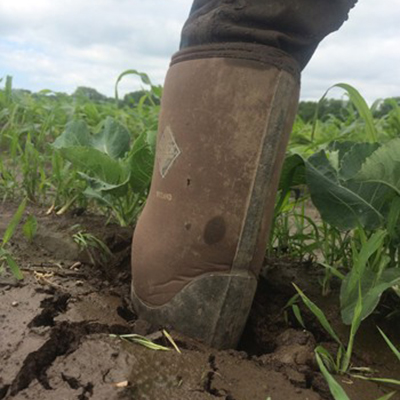Surely the craftsperson must not blame their tools, because the finest work is possible with the most rudimentary instrument. Yet in vegetable growing precise tools can be the difference between profit and loss, or laying down at night feeling just sore instead of broken. There is no scale at which well-designed and accurate tools do not lighten the farmer’s toil. Since my studies as a graduate student began at Michigan State I have been looking to Europe as the source of innovative and precise horticultural tools and machines.
When I first got into vegetable growing I thought that the acme of mechanization was an Allis G cultivating tractor, Planet Jr. planting and weeding tools, and a Buddingh basket weeder. Though wonderful tools, just as useful today as they were sixty years ago, there have been some definite improvements in machinery since then. Europe has continued building tools specifically for horticulture and also those appropriate for small to medium-scales.
I have searched for the causes of these differences in machinery between us and Europe, and it seems there are many, such as more small and medium-sized farms, subsidies to horticultural producers, a higher cost of labor, and more organic growers. Whatever the reason, there is a definite difference in approach to growing vegetables that was evident to me and the American growers I traveled with.
At farms around the US I see glimpses of modern vegetable growing machines in orange Maschio tillers, red Lely power harrows, and yellow finger weeders, all tools made in Europe. But these single European tools on our farms are just snippets of the suite of tools that make up horticultural production systems over there. I found that there are several tools that most European organic vegetable growers use because they work well and they work well together.
As part of the horticulture department at Michigan State University I have had many incredible opportunities to learn more about weeding implements. In this article I will relate what I learned about the equipment used by the French, Dutch, and Swiss vegetable growers that I visited this past March. My experience reflects only what I saw and heard during my two weeks across the pond. All the farms I visited were Organic and generally cultivated more than ten acres and often a lot more. However, good tools are more about principles than size, and I think that the idea of a tool can be brought to life in almost any size.
Though I was most excited to see the weeding tools, I should begin with the tillage machines. I saw only one roto-tiller in Europe. This I found astonishing given that the roto-tiller, whether three-point or walk-behind, is the most common machine among American vegetable growers. For lighter tillage, Europeans preferred the power-harrow. Familiar? JM Fortier popularized this machine in the US. It consists of sets of vertical powered tines that stir the soil without inverting it. Growers used 8 to 15-foot wide three-point models of the power harrow for primary or secondary tillage. Often it was used to create the final bed for transplants.
The other common tillage machine is one that I have never seen in the US. That is what is called a bed shaper, but different from our tool of the same name. To form a final raised-bed here, a tiller is used to create tilth and then a non-powered bed shaper of various kinds is pulled through to form the soil into its final shape. What they call a bed shaper is really a tiller far more thorough than our rototiller combined with a bed shaper in back: two counter-rotating spiked drums (like two counter-rotating roto-tillers) pulverize and deposit the mellow soil in the top few inches while allowing the heavier rocks to sink below. At the back of the machine rollers or press-pans of various shapes are mounted to give a bed of the desired dimension. Although I did not see one in action, these bed shapers appear to give greater tilth and more accurate bed shape all in a single pass, and watching some Youtube videos bears this out. For example see brands like Forigo or Massano.
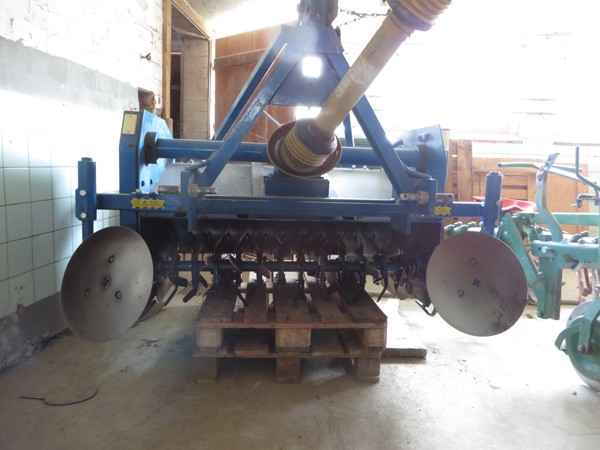
Another tool familiar here that I did not see on the farms I visited was the good old disc. Offset or tandem I don’t think I saw a single one. Instead farmers preferred discs that were vertically, rather than horizontally inclined - tilted towards the ground by an angle of 20 degrees or so. I have heard these called an oblique disc. These acted more like several mini disc-plows.
All of these tillage tools were mounted in many different combinations, for you see, front-mounted implements are the rule in Europe. Tillage tractors had a three-point hitch in both the front and rear. Often the front hitch would include a PTO powered by external hydraulics. I saw many creative implement combinations that turned what would have been two passes through the field into one. For example a fertilizer-spreader on the front and a bed-shaper on the back, or a primary-tillage implement in the front with secondary-tillage in the rear. I noticed that these front hitches were not factory standard but rather an after-market addition.
My favorite was seeing a robotic weeder on the rear-hitch while on the front was a sprayer drenching the lettuce plants. They were spraying a bacteria meant to suppress soil-borne pathogens, protecting the lettuce from any soil thrown onto the leaves by the weeding machine - talk about precision agriculture. The more front-mounted implements I saw the more it made complete sense and I was left to wonder why front-mounted three-point hitches are rare in the US.
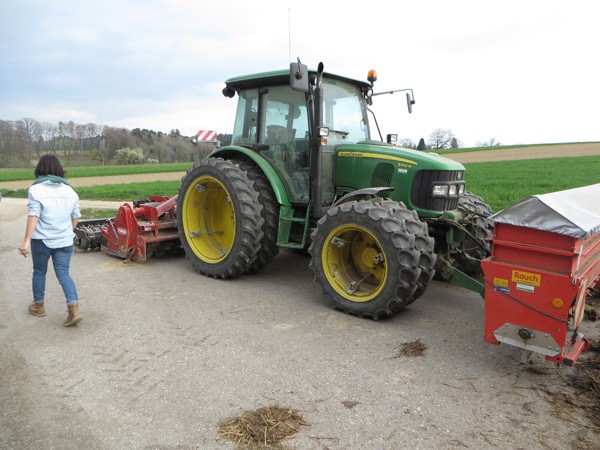
Another way growers were reducing passes through the field was by bolting several implements to each other. I visited a beet and chicory grower in the Netherlands who had a chisel plow followed by a soil-crumbler followed by his vacuum seeder, all hitched behind his tractor! “Why do you do this, so many implements on one hitch?!” I asked, incredulous at the iron monstrosity in front of me. He chuckled, “I am one old man, and I must compete with the giant farms in the US, so we have to be creative.”
Once the soil was prepared, seeding was done generally with vacuum seeders. For transplants soil blocks were used universally instead of plug-trays. Growers appreciated the vigor of soil blocks and their ease of handling. As I mentioned in the last issue of GFM, there is a robust network of greenhouses to produce the soil block transplants, so that all a grower needs to do is call in what variety, how many, and the day they want them delivered.
Smaller growers transplanted soil blocks by hand into holes punched by machine in order to keep rows evenly spaced for later mechanical weeding. But larger growers had soil block transplanters that were a wonder to watch. The soil-blocks arrived from the nursery on pallets of stacked trays. Two people stood on the transplanting machine and with flat trowels scooped lines of soil blocks off of the tray and fed them into the three rows of the machine - like masons whose material is soil and plant instead of mortar and block.
Now on to the subject near to my heart – weeding tools. Some farmers are content with their Allis G’s or Super C’s, but many gripe about the limitations of each model of American cultivating tractor – the most common being that these tractors do not have enough space under the belly, which limits tooling possibilities. In Europe cultivating tractors are called “tool carriers.”

This was one of several terms that I think are more than mere differences in translation. In some cases these different terms describe a more accurate conception of the work performed by the tool. Rather than a tractor that cultivates, itself a broad term, these machines are not built to pull or haul, but rather only to carry weeding tools. While there are extremely slim pickings of cultivating tractors in the US that are less than twenty-five years old, in Europe they never went out of style. I saw Fendt-brand tool carriers from fifty to twenty years old and modern models that are modern marvels.
Let me share a few details about these tool-carriers. They have three hitches! A hitch in the front, in the middle, and the rear. Like the tillage tractors, having several hitches allows for a great deal of flexibility as one may combine many implements into a single pass. Additionally all of these hitch positions can have PTOs. This versatility really increases the options - in addition to running three weeding tools in one pass, I saw tractors using the PTOs by spreading fertilizer in the front or rototilling between rows in the middle.
These tool-carriers have soaring steel beams connecting the rear platform, which houses the engine and operator, with the front wheels. There is plenty of space for belly-mounted implements between the front and back wheels and vertically between the ground and the frame. The three-point hitches often have hydraulic top-links. Which turns out to be quite helpful when it comes to weeding implements: lengthening and shortening the top-link from the operator’s seat is the quickest and most uniform way to change the aggressiveness of a mid-mounted weeding tool, whether finger weeder or sweeps. This makes it easy for operators to adjust a tool as soil conditions change and without stopping to pull out a wrench.
Newer tool-carriers could shift the mid-mounted tool side to side, similar to a fork-lift. I can’t say that I see this particular adjustment as crucial, but hey, why not, Europe. These European tool-carrier tractors are available in the US for around $20,000 through companies like KULT-KRESS. The Tilmor Company in Ohio is soon coming out with a promising American-made cultivating tractor. Both of these tractors will be demonstrated at the upcoming Midwest Mechanical Weed Control Field Day.
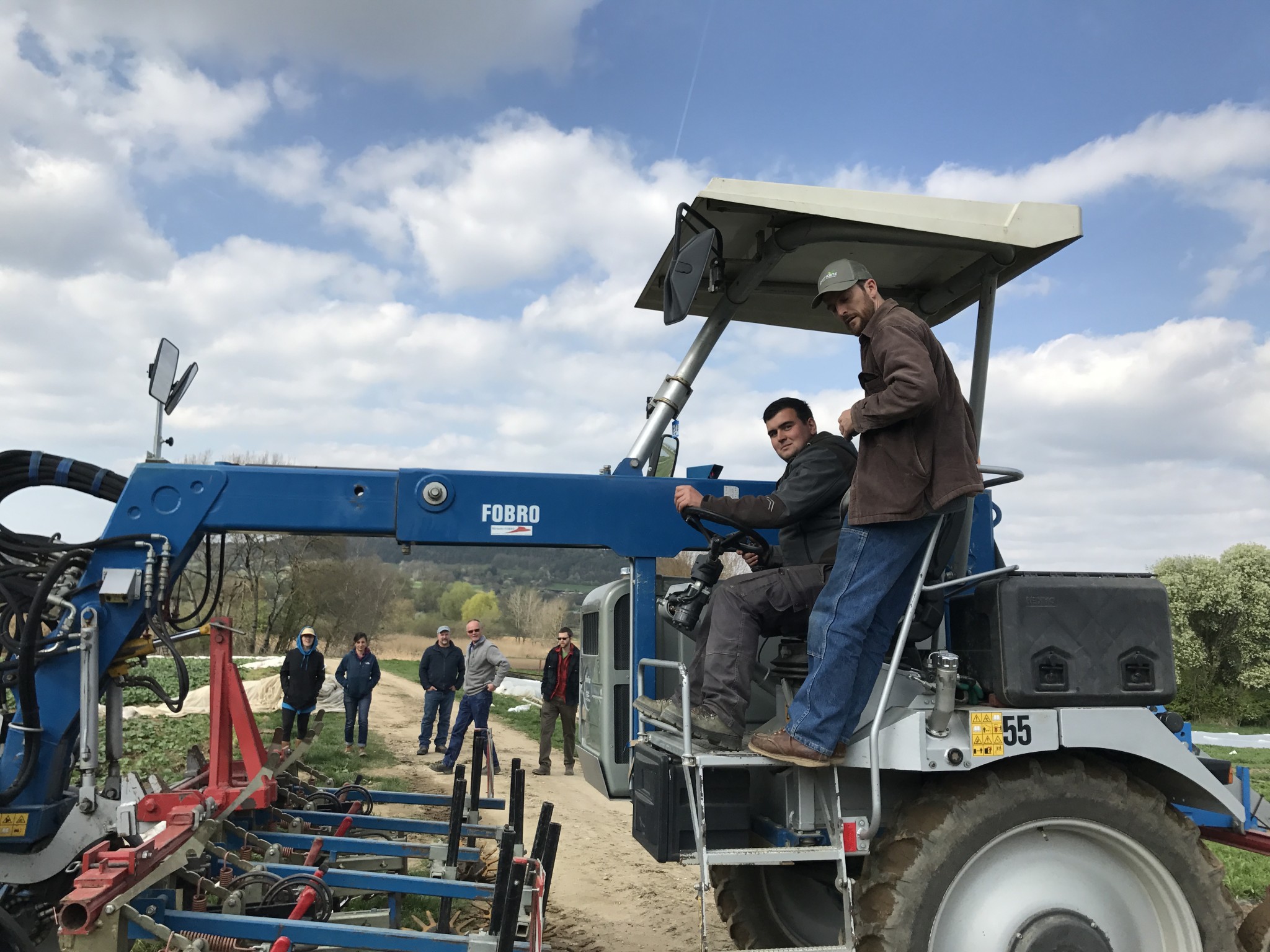
I did visit one large organic vegetable grower in the Netherlands who did not use his tool-carrier much. Instead, at his large size, he planted onions and carrots using a GPS-guided seeder with millimeter accuracy. When it was time for the first cultivation, even before the seedlings were visible, he would run a GPS-controlled rear-mounted weeding tool between the rows using the GPS map generated during planting. In this way he could cultivate faster and sooner. GPS tractor and implement guidance is common among row-crop growers in the US, and I imagine that larger vegetable growers here use the system as well. Should we assume that it is just a matter of time until the price comes down and smaller growers are using this technology?
When it came to the actual weeding tools, I was blown away by the precision and forethought in design that I observed. That’s what’ll happen when 21st century design and manufacturing are applied to weeding tools instead of herbicides. It is important to note at the beginning of any discussion of physical weeding tools that none are magic – rather, prior cultural weed control and proper soil and plant preparation are more important than the tool and determine how accurately it can work. Having said that, there were some really sweet implements.
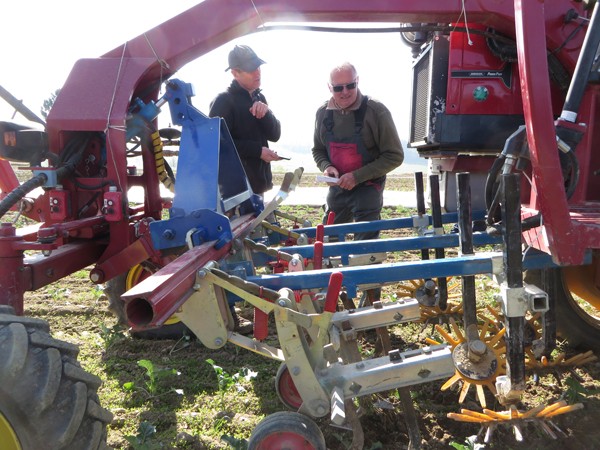
All weeding tools mounted to a single style of toolbar that appeared to be universal across brands and era. The tools clamped onto it, rather than bolting through holes in the toolbar, and this arrangement allowed tools to slide to any position horizontally on the toolbar by loosening a single bolt a few turns. Also across brands, adjustments to the weeding tools were commonly made by loosening a 19mm bolt. In many cases adjustments were even easier, like spring-loaded levers that changed gauge-wheels depth to pre-set increments with the flick of a wrist.
For between-row weed control sweeps were the most common tool, just like here. However, the design of the European sweeps acknowledged a cardinal rule of mechanical weed control - most weeds germinate from just the top inch and a half of soil. That is to say that working the soil deeper than 1.5’’ only brings up weed seeds that otherwise would have remained dormant if left undisturbed. The European sweeps are thinner than ours and flatter, with a low angle into the soil, so that they cut just the top layer of soil and do not dig deeper into the soil than necessary.
It may seem like I am getting down on American horticultural tools, and lest you think that I have a bias, I want to let you in on something – most of the innovative European weeding tools are based on American designs. Yep, finger weeders, torsion weeders, star-weeders, and several others originated in the U.S. of A. I met the former owner of a Swiss tool company who told me the origin stories of several tools. A Buddingh finger weeder was brought to Germany and became the prototype for the simpler models made now. Similarly Bezzerides torsion weeders were the inspiration for the European versions, and Lilliston cultivators were “redesigned with Swiss precision” and became star-hoes. Let us look briefly into these European re-boots of American classics. Perhaps a future article will describe the use of these tools in greater detail.
Finger weeders were used near universally and other than sweeps were the most common weeding tool. Though new to the US I was told that growers had been using them for at least ten years. Finger weeders were mid-mounted on tool carriers with attendant hoeing elements for the between-row area. They were used extensively and aggressively on all transplants. Again, the most common adjustment to the finger weeder tool was changing the length of the top link so as to dip it further into or away from the soil.
The other very common tool I saw, which I have never seen here, is what is called a star-hoe, or what we might call a steerable Lilliston cultivator. Every farm seemed to have a version of this tool, which consisted of a rear-mounted steerable toolbar with long arms holding the heavy gangs of toothed wheels. Like a Lilliston cultivator this tool had gangs of toothed wheels that crumble the soil and hill it up or pull it down, depending on how the toothed wheels are angled. The European style allowed for individual ‘star-hoes’ to be inserted or removed from a gang. It is very common in Europe to grow certain crops on ridges about 1 foot tall, such as potatoes and carrots. The star-hoe was used for this ridge culture to work soil close to the crop and maintain accurate ridges. Hatzenbichler is the current manufacturer of this tool.
Like here, farmers had suites of weeding tools each for just the right conditions. I found the tools to be in good repair and sometimes, when sitting in the shed they were fitted with removable wheels that made them simple to move around the shop and maneuver under the tool-carrier. If you would like to see many of these weeding tools and tool-carriers in action search for ‘mechanical weed control in vegetable production’ on Youtube for a spectacular video.
My favorite book tells me that when I come upon something good, the first thing to do is share it so that the good spreads out. To that end, our team at Michigan State University is proud to host a field day to share mechanical weeding tools and experience. If you would like to see many of these European weeding tools demonstrated, talk to growers who visited these European farms, and meet the companies who are selling them in the US including Cultitrack, Tilmor and Oggun, come to the Midwest Mechanical Weed Control Field Day in Lansing, Michigan on September 26th (see ad p. 20). Additionally, many pictures and videos of the tools I described, as well as interviews with manufacturers explaining their weeding tools, are posted on the ‘Cultivation Field Day’ Facebook page.
It is my hope that I shared something new and useful with you in this article. Before I see you again at the field day, I would like to affirm the role played by three organizations who supported this trip to Europe – North Central SARE (part of the USDA), the Michigan Vegetable Council, and Michigan State University Horticulture Department.
Sam Hitchcock Tilton is a former and aspiring vegetable grower who has visited with farmers around the world. He is currently studying for a Master’s degree at Michigan State University, focusing on organic weed control and researching, testing, and building mechanical weeding machines. He has a passion for developing the finest popcorn strain and enjoys learning more and sharing his knowledge.

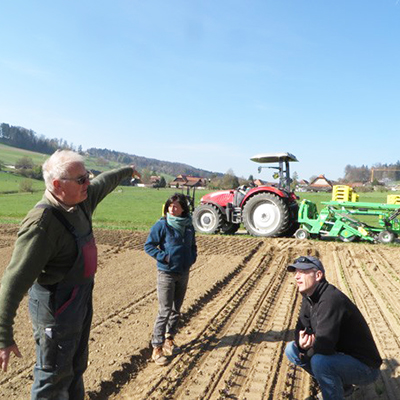
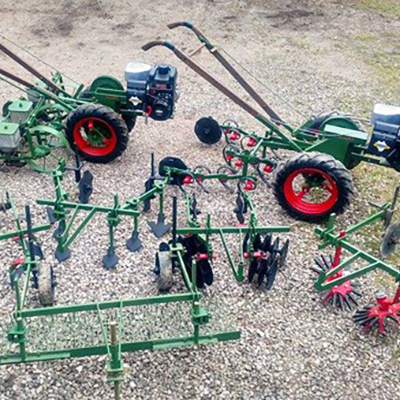
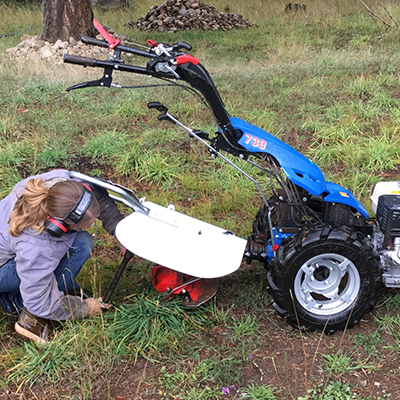
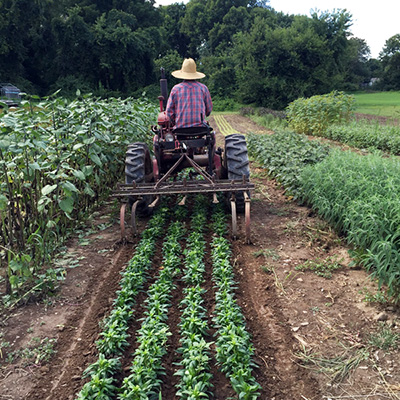

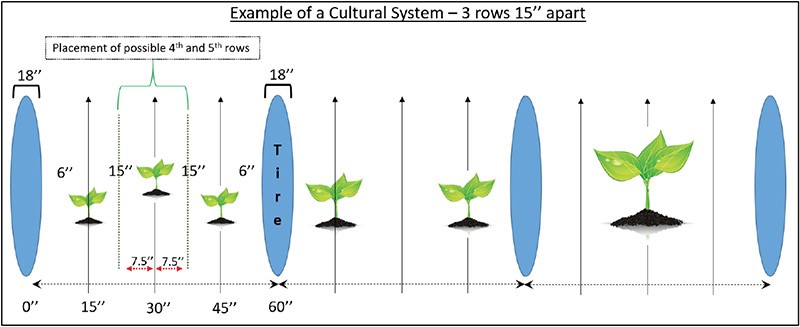 Like Indiana Jones tenaciously searching for the Holy Grail, similarly I, for years, have questioned farmers, searching for the one true row-spacing. With so many possible configurations for tractor-tire spacing, bed-top size, number of rows in a bed, and inches between rows – I felt there had to be one configuration to rule them all.
Like Indiana Jones tenaciously searching for the Holy Grail, similarly I, for years, have questioned farmers, searching for the one true row-spacing. With so many possible configurations for tractor-tire spacing, bed-top size, number of rows in a bed, and inches between rows – I felt there had to be one configuration to rule them all. 